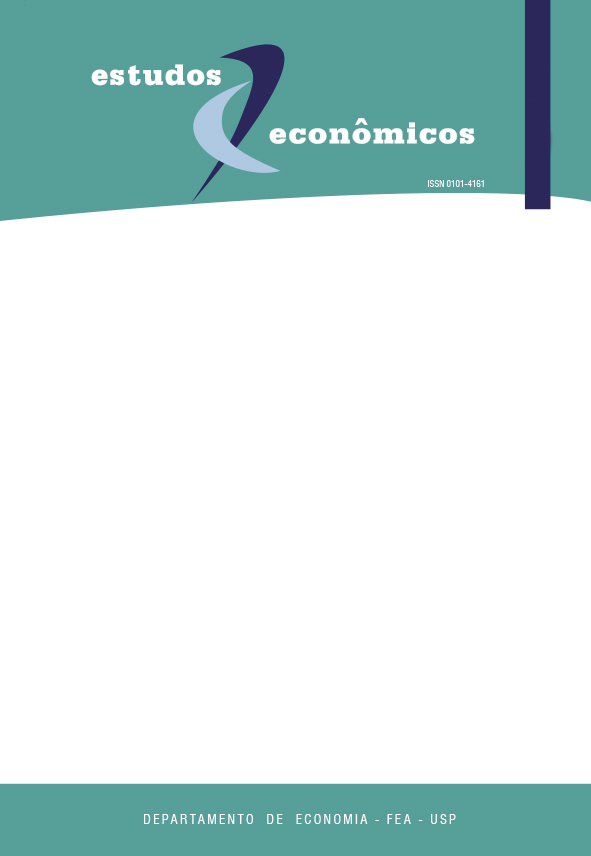O impacto da escolaridade sobre a distribuição de renda
DOI:
https://doi.org/10.1590/S0101-41612010000400001Keywords:
income distribution, education, semiparametric methodAbstract
This paper investigates the impact of education on income distribution of Brazilian states and regions, using a semi parametric method, following Dinardo, Fortin and Lemieux (1996) and dataset from the PNAD 1999. Contrafactual densities were constructed weighting the distribution of the poorest region/state (Northeast / Ceará) by the profile of education in the richer one (Southeast / São Paulo). Results: between 12% and 36% of the difference in income is explained by the educational differences; the weighting by education increased by about 55% the average income in counterfactuals; the counterfactual income of the Northeast amounts to 93% of the average Brazilian income; the higher the percentile considered income, the greater the contribution of the difference in schooling for the difference in income; and the income dispersion of the poorest regions increases when they provide the level of schooling of the richest regions, while the wage profile of the region is kept constant.
Downloads
References
of education. IPEA, 1993. (Texto para Discussão n. 311)
BARROS, R. P. de; MENDONÇA, R. Os determinantes da desigualdade no Brasil.
IPEA, 1995. (Texto para Discussão n. 377)
BARROS, R. P. de; CAMARGO, J. M.; MENDONÇA, R.. A estrutura do desemprego
no Brasil. IPEA, 1997. (Texto para Discussão n. 478)
BLINDER, A. S. Wage discrimination: reduced form and structural estimates. Journal
of Human Resources, v. 8, n. 4, p. 436-455, 1973.
BOURGUIGNON, F.; FERREIRA, F.; LEITE, P. Beyond Oaxaca-blinder: accounting
for differences in household income distributions across countries. 2002. Mimeo.
BUTCHER, K. F.; DINARDO, J. The immigrant and native-born wage distributions:
evidence from United States censuses. NBER Working Paper Series 6630, 1998.
DINARDO, J.; FORTIN, N. M.; LEMIEUX, T. Labor market institutions and the
distribution of wages, 1973-1992: A Semiparametric Approach. Econometrica,
v. 64, n. 5, p. 1001-1044, 1996.
Ferreira , P. C. Regional policy in Brazil: a review. WorldBank, 2004. Mimeo. Available
at: <http://www.fgv.br/professor/ferreira/RegionalPolicyFerreira.pdf>.
KRZANOWSKI, W. J. Non-parametric estimation of distance between groups.
Journal of Applied Statistics, v. 30, n. 7, p. 743-750, 2003.
OAXACA, R. Male-female wage differentials in urban labor markets. International Economic Review, v. 14, n. 3, p. 693-709, 1973.
PARK, B. U.; MARRON, J. S. Comparision of data-driven bandwidth selectors.
Journal of American Statistical Association, n. 85, p. 66-72, 1990.
PARZEN, E. On estimation of a probability density function and mode. The Annals
of Mathematical Statistics, v. 33, n. 3, p. 1065-1076, 1962.
PESSOA, S. Existe um problema de desigualdade regional no Brasil? 2000. Mimeo.
ROSENBLATT, M. Remarks on some non-parametric estimates of a density function.
The Annals of Mathematical Statistics, v. 27, n. 3, p. 832-837, 1956.
SHEATER, S. J.; JONES, M. C. A reliable data-based bandwidth selection method
for kernel density estimation. Journal of Royal Statistical Society, v. 53, n. 3, p. 683-690, 1991.
SILVERMAN, B. Density estimation for statistics and data analysis. London: Chapman
& Hall, 1986.
Downloads
Published
Issue
Section
License
Copyright (c) 2010 Marcio Antonio Salvato, Pedro Cavalcanti Gomes Ferreira, Angelo José Mont'Alverne Duarte

This work is licensed under a Creative Commons Attribution-NonCommercial 4.0 International License.
By submitting an article, the author authorizes its publication and attests that it has not been submitted to any other journal. The original article is considered final. Articles selected for publication are proofread for grammatical and orthographic errors. The journal does not pay rights for published articles. The Institute of Economic Research from the School of Economics, Business and Accounting of the University of São Paulo (Instituto de Pesquisas Econômicas da Faculdade de Economia, Administração e Contabilidade da Universidade de São Paulo) owns the journal's copyright.





 Atualizado em 14/08/2025
Atualizado em 14/08/2025